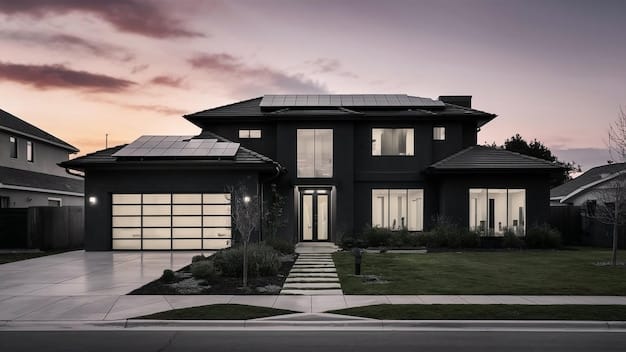Promising Solar Panel Innovations for Increased Efficiency in the US

The most promising innovations in solar panel technology for increased efficiency in the US include perovskite solar cells, bifacial solar panels, smart solar panels, and advancements in energy storage solutions, all contributing to a more sustainable and efficient energy landscape.
Discover the future of energy in the US with cutting-edge solar panel technology. This article delves into the most promising innovations in solar panel technology for increased efficiency in the US, revealing how these advancements are revolutionizing the energy sector.
Innovations in Solar Panel Technology for Increased Efficiency in the US
Solar energy is becoming an increasingly vital component of the US energy mix, and ongoing technological advancements are continuously improving its efficiency. These innovations promise to make solar power more accessible, affordable, and reliable for homes and businesses across the nation.
Let’s explore some of the most exciting breakthroughs in solar panel technology that are poised to transform the energy landscape.
Perovskite Solar Cells
Perovskite solar cells are a rising star in the solar energy field, offering the potential for higher efficiencies and lower production costs compared to traditional silicon-based cells.
Here’s why they are so promising:
- Enhanced Efficiency: Perovskite materials can absorb a wider range of the solar spectrum, leading to higher energy conversion rates.
- Lower Manufacturing Costs: The materials are abundant and easier to process than silicon, reducing production expenses.
- Flexibility: Perovskite cells can be manufactured on flexible substrates, opening up new applications like solar-powered clothing and flexible solar panels for curved surfaces.
Despite their promise, perovskite solar cells face challenges related to long-term stability and environmental concerns due to the presence of lead. Research efforts are focused on addressing these issues to unlock their full potential.
Bifacial Solar Panels
Bifacial solar panels are designed to capture sunlight from both their front and back surfaces, significantly boosting their energy output.
Here’s how they enhance efficiency:
- Increased Energy Yield: By capturing reflected light from the ground and surrounding structures, bifacial panels can generate up to 30% more energy than traditional monofacial panels.
- Versatile Applications: They are particularly effective in ground-mounted solar farms and on rooftops with reflective surfaces.
- Improved Performance: The dual-sided exposure helps to cool the panels, which can improve their performance and lifespan.
Bifacial solar panels require careful installation to maximize their efficiency. Factors such as ground reflectance, panel height, and row spacing need to be optimized to take full advantage of their dual-sided capabilities.

Smart Solar Panels
Smart solar panels integrate advanced electronics and software to optimize energy production and monitor performance in real time.
Key features of smart solar panels include:
- Module-Level Monitoring: Each panel can be monitored individually, allowing for quick detection and diagnosis of performance issues.
- Maximum Power Point Tracking (MPPT): MPPT technology optimizes the energy output of each panel independently, maximizing overall system efficiency.
- Remote Control and Diagnostics: Smart panels can be remotely controlled and diagnosed, reducing maintenance costs and improving system uptime.
Smart solar panels are particularly beneficial in complex installations where shading or panel mismatch can significantly impact energy production. They provide valuable data and control capabilities that enhance the overall performance and reliability of solar energy systems.
Advancements in Energy Storage Solutions
Efficient energy storage is critical for addressing the intermittency of solar power and ensuring a reliable energy supply. Innovations in battery technology and energy management systems are playing a crucial role in this area.
Significant improvements include:
- Lithium-Ion Batteries: Lithium-ion batteries are becoming more affordable and energy-dense, making them ideal for residential and commercial solar energy storage.
- Flow Batteries: Flow batteries offer scalability and long lifespans, making them suitable for grid-scale energy storage applications.
- Smart Inverters: Smart inverters manage the flow of energy between solar panels, batteries, and the grid, optimizing energy usage and grid stability.
Energy storage solutions are essential for maximizing the benefits of solar energy, allowing homeowners and businesses to store excess energy generated during the day and use it during periods of low sunlight or peak demand.

Concentrated Solar Power (CSP)
Concentrated Solar Power (CSP) systems use mirrors or lenses to focus sunlight onto a small area, generating heat that can be used to produce electricity. This technology is particularly promising for large-scale solar power plants.
Here are some key advantages of CSP:
- High Efficiency: CSP systems can achieve high energy conversion rates, especially when combined with thermal energy storage.
- Dispatchability: CSP plants can store thermal energy for later use, providing a more reliable and dispatchable power source compared to traditional solar PV systems.
- Grid Stability: CSP can help stabilize the grid by providing a consistent and predictable power supply.
CSP technology is best suited for regions with high solar irradiance, such as the southwestern United States. Ongoing research is focused on improving the efficiency and reducing the costs of CSP systems to make them more competitive with other renewable energy sources.
Quantum Dot Solar Cells
Quantum dot solar cells are an emerging technology that utilizes tiny semiconductor nanocrystals to absorb sunlight and generate electricity. These cells have the potential to achieve very high efficiencies and can be manufactured using low-cost materials.
Key features of quantum dot solar cells include:
- High Theoretical Efficiency: Quantum dots can be tuned to absorb specific wavelengths of light, potentially exceeding the Shockley-Queisser limit for traditional solar cells.
- Low-Cost Materials: They can be made from abundant and inexpensive materials, reducing production costs.
- Scalability: Quantum dot solar cells can be manufactured using solution-processing techniques, making them easily scalable for mass production.
Despite their promise, quantum dot solar cells are still in the early stages of development, and challenges related to stability and toxicity need to be addressed before they can be widely deployed.
Conclusion
The most promising innovations in solar panel technology for increased efficiency in the US are paving the way for a cleaner, more sustainable energy future. From perovskite and bifacial solar cells to smart panels and advanced energy storage, these technologies are enhancing the efficiency, reliability, and affordability of solar power. As research and development efforts continue, we can expect even more groundbreaking advancements that will further transform the energy landscape.
| Key Innovation | Brief Description |
|---|---|
| 💡 Perovskite Cells | Higher efficiency, lower cost potential. |
| ☀️ Bifacial Panels | Captures sunlight from both sides for increased output. |
| 🔋 Energy Storage | Addresses intermittency with battery tech. |
| 🔬 Quantum Dots | Potential for very high efficiencies. |
Frequently Asked Questions (FAQ)
▼
Perovskite solar cells are promising due to their potential for higher efficiency and lower production costs compared to traditional silicon-based solar cells, making them a cost-effective alternative.
▼
Bifacial solar panels increase efficiency by capturing sunlight from both the front and back surfaces, which can significantly boost energy output compared to traditional monofacial panels.
▼
Energy storage is vital for addressing the intermittency of solar power. It ensures a reliable energy supply by storing excess energy generated during the day for use during periods of low sunlight.
▼
Smart solar panels offer module-level monitoring, maximum power point tracking, and remote control capabilities, which help optimize energy production and monitor performance in real time.
▼
Concentrated Solar Power (CSP) systems use mirrors or lenses to focus sunlight onto a small area, generating heat that can be used to produce electricity, often combined with thermal energy storage.
Conclusion
In conclusion, the continuous advancements in solar panel technology are driving significant improvements in efficiency and sustainability within the US energy sector. These innovations promise a cleaner and more reliable energy future for homes and businesses alike.





